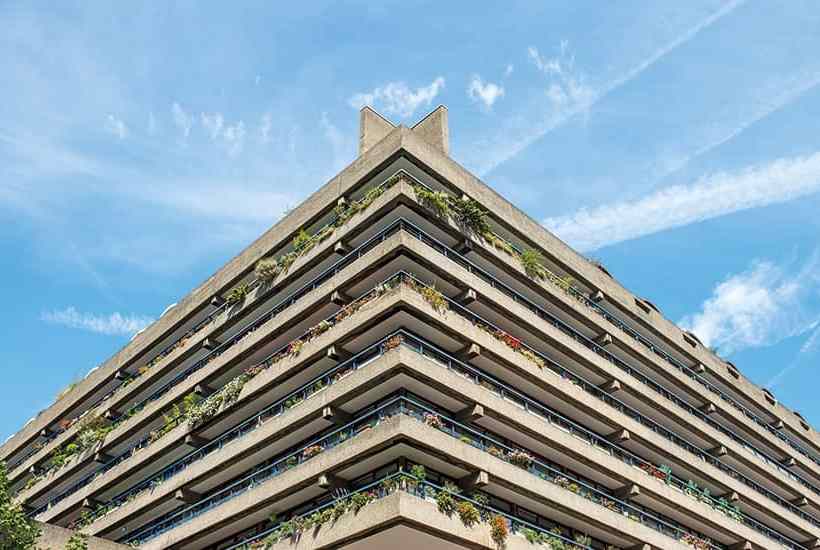Nothing divides the British like modernist architecture. Traditionalists are suspicious of its utopian ambitions and dismiss it as ugly; proponents romanticise it, yearn for the civic principles that built it and gloss over its failings; the young see period charm in flat roofs and straight lines, while the old associate them with deprivation; the wealthy mostly avoid it — and many people have no choice but to live in it. Nearly 100 years after Le Corbusier set out his five points of modern architecture the British are still arguing about its merits, partly because we still live with so much of it: housing, offices and civic and industrial buildings.
Two new books may change our perspective — or at least convince us that neither side is entirely right. The first, by the cultural journalist Owen Hatherley, is a weighty, glossy gazetteer of the most significant British modernist buildings. The second is a celebration of the Barbican Centre, London’s cherished late-modernist arts and housing complex, written to mark its 40th anniversary. Read together, they make a persuasive case for preservation.
Hatherley, the culture editor of Tribune, is a leftish champion of modernism. He has produced a sprawling study, packed with pleasurable details and prefaced with an essay that traces the roots of British modernism from blank Victorian warehouses through the expressive brutalism of housing estates and beyond into an imagined future. He is flexible in his dates and definitions, and includes 21st-century buildings, such as Hastings Contemporary (2012), which allow us to recognise that modernist principles are still with us. This is no dead trend.
He is as interested in modest modernism — council estates such as Wythenshawe in Manchester and Catford shopping centre — as he is in Hampstead’s private Corbusian villas or grand projects such as the Southbank Centre. To Hatherley, mundane structures express a revolutionary approach to ‘who builds in a city, how they build and in whose interest’.
He is trenchant, never fawning; a provocateur, and a good one — and more entertaining than Nikolaus Pevsner, whose directories of English buildings are authoritative but neutral. But he is also didactic, and his prose lacks the contemplative charm of, say, Ian Nairn, whose Nairn’s London of 1966 is a model of the craft of writing about buildings for a general readership. Nairn also sought out the ordinary, but he reflected rather than lectured, and placed human experience at the core of architectural writing.
Hatherley’s detailed knowledge can occasionally make him sound overly purist, even dismissive. Many readers may be doubtful about the South Bank Centre but admire the art deco Odeon cinemas designed by Harry Weedon in the 1930s. Though ubiquitous and suburban, these fun palaces embody a collective cultural memory. To Hatherley, they are ‘cheap and nasty’ and ‘shamelessly filched from Erich Mendelsohn’s Universum Cinema in Berlin’. He is right, but his tone risks alienating casual enthusiasts.
Nevertheless, he writes glorious contextual critiques. Liverpool’s Italian futurist-style ventilation towers of the Kingsway Tunnel which runs beneath the Mersey reflect a dystopian early 1970s aesthetic, ‘as if the start of the city’s sharp decline pushed designers into producing images of fantastical domination and surreal aggro’. And he can be emotional and affecting. Coleg Harlech, in north Wales, a startling early 1970s brutalist structure by Colwyn Foulkes with a precarious future, is ‘extremely hard to write about without falling into incoherent rage’, and its neglect is ‘a terrible collective failure, sickening in its implications’.
Then there is the Barbican, which Hatherley describes as ‘one of the most convincing visions of the alternate city built anywhere in the world during the 20th century’. He notes that it is modernism for the wealthy, and operates ‘alongside the existing city, not as part of it’. (Barbican housing was never social in the conventional sense.) Being concrete, and therefore opaque, outsiders cannot see in. But for all its limitations, the Barbican shows us what well-funded, cherished modernism can achieve.
Nicholas Kenyon’s Building Utopia is vogueish, more accessible, gift-shop modernism (its acid-orange cover is a little off for its era: more 1960s cladding than early 1980s ochre). It focuses on the Barbican’s artistic achievements, which makes the title slightly misleading. But it is a visual delight, and illuminating on architectural history.
Kenyon, a music critic, author and former controller of BBC Radio 3, was managing director of the Barbican until last year. He has invited various historians to chronicle the Barbican’s conception and critics to appraise its cultural contribution — Fiona Maddocks on music, Lyn Gardner on theatre and so on. Their reflections are presented with archive material and fragments of oral history contributed by the centre’s artistic administrators.
The cultural historian Robert Hewison is detailed and thorough, if a little dry, on how the Barbican grew out of an assortment of post-war endeavours: Patrick Abercrombie’s County of London Plan of 1943;J.M. Keynes’s formation of the Arts Council two years later; and Jim Haynes’s anti-establishment Arts Labs of the 1960s. Elain Harwood offers a lively account of how the architects Chamberlin, Powell and Bon got the thing built, and is particularly illuminating on its top-quality auditoriums, cinemas and fabulously generous staircase and bar areas. But conditions for the builders were dangerous, and the project was beset by strikes.
Despite this celebratory publishing, we are just as casual today about the destruction of our most cherished modernism as we are about council estates. This year a significant part of the Barbican is under threat, despite its Grade II listing, with plans to demolish the Museum of London and the adjacent Bastion House, an elegant 1970s office block, to make way for heftier redevelopment (I can’t find any mention of this in Kenyon’s book).
The British may have reservations about their modernist architecture. At its worst it can be cheap, rigid and prescriptive. But we cannot demolish it all, and we shouldn’t want to. Its aesthetics may not please everyone, but it reflects many of our best endeavours: housing, work, culture, industry. The loss of that memory would be irreversible.
Got something to add? Join the discussion and comment below.
Get 10 issues for just $10
Subscribe to The Spectator Australia today for the next 10 magazine issues, plus full online access, for just $10.
You might disagree with half of it, but you’ll enjoy reading all of it. Try your first month for free, then just $2 a week for the remainder of your first year.














Comments
Don't miss out
Join the conversation with other Spectator Australia readers. Subscribe to leave a comment.
SUBSCRIBEAlready a subscriber? Log in